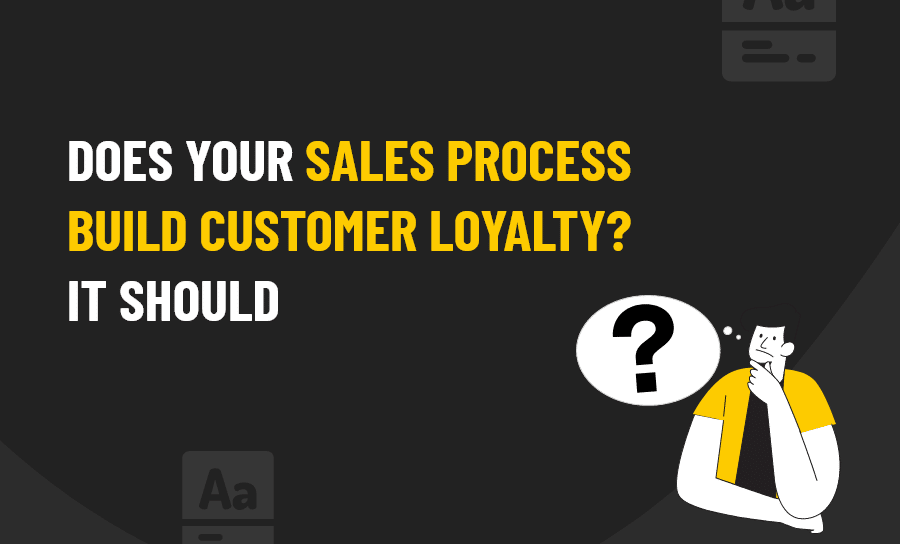Customer experience, client success and customer loyalty are big buzzwords in any business niche, and for good reason.
When you wow your customers and are proactive about their needs, you build a powerful sense of loyalty that boosts retention and even leads to clients purchasing additional products and services beyond the first sale – something that is always a plus, especially in the climate of economic uncertainty the whole world currently finds itself in the face of COVID-19. Here we are going to take a closer look at the role your sales process plays – or should play – in building the loyal customer base any company needs to thrive.
The Value of Customer Loyalty
Keeping your current customers happy and making repeat purchases is key to growth for almost every business. Data shows customers who are loyal to your business and brand are better for your bottom line.
• According to Marketing Metrics, the probability of selling to an existing customer is up to 14 times higher than the probability of selling to a new customer.
• Bain & Company and Harvard Business School report that “increasing customer retention rates by 5% increases profits by 25% to 95%.”
• Research found that existing customers are 50% more likely to try new products and spend 31% more, on average, compared to new customers.
• According to Hubspot, new customer acquisition costs have increased by almost 50% in the past five years.
That’s not all that data says loyal customers can contribute to your business’ growth. Treated right they become passionate brand advocates, without you needing to pay a penny for the invaluable marketing boost that will give you when trying to attract new customers. According to Qualtrics XM, 77% of customers would recommend a brand to a friend after a single positive experience, so every interaction counts.
The Role of The Sales Process in Customer Loyalty
There are lots of critical parts of your business you have to pay close attention to. The problem, however, is that most conversations about improving customer experience totally leave out the role that your sales process plays.
In reality-and, this has been our experience with our lead generation clients and the prospects they engage-the true potential of customer loyalty or customer experience begins – and is rooted in your sales process. A satisfied customer is one that will come back again and again.
Here’s why:
Your sales process represents some first impressions a future client has of your business and how your company works. It’s great that you have spent lots of time and money honing the talents of your customer service team but if a sale isn’t made, they will never get to show those skills off.
- Your sales process is an opportunity to walk away early from prospects who aren’t a good fit and to zero in on ideal prospects. It wastes no one’s time, and no one gets upset.
- Your sales process paints a vision for your future client and sets expectations that your business then has to meet. Those expectations include not only service and deliverables but also the dynamic of how you and your future client will work together.
- but also the dynamic of how you and your future client will work together.
When your sales process does not align with the business-for example, the salesperson who will say anything to get a sale and leaves dealing with client confusion and frustration in the hands of your service team-client loyalty ultimately suffers.
On the other hand, if your salesperson paints an exciting vision of what working with your business will be like and what unique benefits you can provide, delivering on those benefits is a compelling statement about who you are and how you work.
If you approach sales as the beginning of your client-experience opportunity, that should reframe and challenge how you and your team are approaching sales today.
In our work, we have learned that companies can be very successful when they employ the following opportunities and tactics to use their initial sales process to drive client loyalty and increase customer retention.
Know Who You Are and What Makes Your Offerings Compelling.
We describe this as storyboarding because much of the first engagement with a prospect is all about storytelling and setting a scene.
If you can communicate what sets you apart from your competition from the first interaction, you can carry that momentum from sales all the way through service. If you don’t know what makes you special, your prospects and clients won’t figure it out for you, so this is something it’s crucial you establish from the start.
Forget Under- or Over-Promising.
Promise, and deliver. That’s it. If you under-promise in the sales pitch, you hide your true value from the prospect, which cripples your momentum right out of the gate and may see you lose to a competitor who was less modest and more proactive in describing their value or the value of their products and services.
If you over-promise, well, that one is obvious. Deception never ends well. Instead, know what makes you great, and concentrate on delivering that into that so you fully meet client expectations when they sign on.
Empower Your Sales Team to Say No.
Not all business is good business. Some clients just don’t fit and the truth is that there is very little your products or services can do for them.
If you focus on bringing in the right clients-those who fit your culture and your specialities-you dramatically reduce the friction in your business and set your team up for success. This means you have to give your sales team the power to say no to what is obvious to them will not be a good deal.
If you consistently allow problem clients into your business, your once enthusiastic, happy and talented team will become seriously disillusioned and demoralized, and that angry phone call they had with “that guy” can spill over into the next interaction with your top client. Or lead to them storming out of the office, never to return.
Was that one problem client worth losing a talented team member for? The answer is rarely yes.
Keep the Momentum Going After the Handoff.
Your salesperson is the first person to represent your brand, but the transition from sales to service and beyond are also important. For your prospect, the experience should be consistent and seamless, so when you decide on a message for your sales team, extend that message throughout the rest of your business.
As prospects and clients interact with various team members, it should all feel like the same business to them, so get your entire business on the same page so that you can create that easy, seamless process customers and clients are always hoping for.
Therefore, it is important to choose carefully when you outsource any part of the sales process, especially lead generation. Although not formally a part of your business, and although they may not be the ones closing the sale – that one is still down to you – they do represent your business. This means their standards, and their expertise has to align closely with yours. Building relationships in such a way is key to your retention strategy.
Pearl Lemon Leads has a proven track record of being able to align with client businesses seamlessly. Get in touch today to discuss how we can help you.






